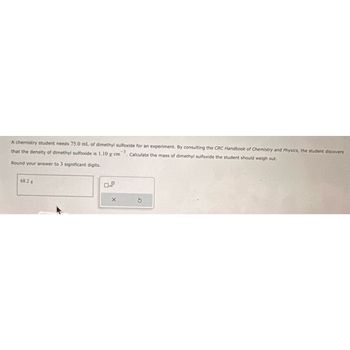
Chemistry
10th Edition
ISBN: 9781305957404
Author: Steven S. Zumdahl, Susan A. Zumdahl, Donald J. DeCoste
Publisher: Cengage Learning
expand_more
expand_more
format_list_bulleted
Question
smr.4

Transcribed Image Text:A chemistry student needs 75.0 mL of dimethyl sulfoxide for an experiment. By consulting the CRC Handbook of Chemistry and Physics, the student discovers
that the density of dimethyl sulfoxide is 1.10 g-cm3. Calculate the mass of dimethyl sulfoxide the student should weigh out.
Round your answer to 3 significant digits.
68.2 g
X
S
Expert Solution
This question has been solved!
Explore an expertly crafted, step-by-step solution for a thorough understanding of key concepts.
Step by stepSolved in 3 steps

Knowledge Booster
Learn more about
Need a deep-dive on the concept behind this application? Look no further. Learn more about this topic, chemistry and related others by exploring similar questions and additional content below.Similar questions
- You were tasked to separate the components of a mixture containing silica, sodium chloride and charcoal. TNāCI dissolves in water while silica and charcoal are not water-soluble. Only charcoal dissolves in carbon disulfide. a. Write a short experimental procedure to carry out the separation of the mixture. b. Given the following data, determine the percentage of charcoal, sodium chloride and silica. Mass (g) Mass of beaker 100.000 Mass of beaker + mixture 110.000 mass of evaporating dish 62.000 mass of evaporating dish + solid after evaporation of water 65.000 Mass of beaker + charcoal + silica after evaporation of excess water 117.000 mass of beaker + silica after decanting dissolved charcoal and drying 113.545arrow_forward4. What is the product of the following reaction? .Coga x soiomS Snoitoron oiwolloi odilo tonborg Br HO a. II ug b. III но C. AI е. AIarrow_forwardThe starting material to obtain the following product is: a. III b. IV c. I d. IIarrow_forward
- A Moving to another question will save this response. uestion 7 A sample of 121 has a half hfe of 1.7z 10' years. How many years would it take for the reactivity of the sample to fall to 5% af ats curent level? 29, Moving to another question will save this response. ake Test FFNALarrow_forwardQ7. Fill in the missing intermediates, products and reagents in the reaction scheme shown below. 1. KMnO. KOH (aq) 2 HCI (an) 1. BaHe, THF 2. H,Oz. NaOH Compound A Compound B conc. H,PO, 1. PhMgBr CH,N, 2. HCl in H,0 heat Compound C Compound D 1. BHe. THF 1. NaH 2. H;O,. NaOH 2. Compound C Compound E Compound F Compound G Q8. Provide a plausible mechanism that leads to the major product of the reaction scheme shown below. 1. SOCI, HO, 2. NH(CH)2 Q9. Provide a plausible mechanism that leads to the major product of the reaction scheme shown below. 1. PBr3. Cl2 он 2. H,0 Q10. Provide the starting material needed to create the below product using m-chloroperbenzoic acid as the active reagent. Then draw the mechanism that facilitates this transformation.arrow_forwardO Reagents Available a. CH₂=CHCH₂CI, AICI 3 CH3 b. CH₂Br₂, OH™ C. CH3CH₂COCI, AICI 3 d. H₂, Pt e. NBS, CCI4 f. K* tBuO™ g. CO, HCI, CUCI/AICI3 h. CH3CH₂CH₂COCI, AICI 3 i. BrCH₂CH₂Br, OH- j. CH3CH₂CI, AICI 3 k. RCO3H I. H3O+ Using conditions from the table, show how you would synthesize this compound from catechol (1,2-benzenediol). Select reagents from the table in the order that you wish to use them, i.e. aced; do not include punctuation or spaces. If more than one route exists, choose the shorter one; in no case will a synthesis require more than 5 steps.arrow_forward
- Saved Normal BIIIU fxl Ix Actual mass used in solution prep (g) Volume solution prepared Measured conductivity (uS/cm) Substance 0.1 g Naci 0.1003 100 mL 1149 0.1 g Nal 0.10 100 ml 419 Calculate the mass of Nal that would be necessary to yield the same conductivity as the NaCl solution. Clearly show these calculations in your lab notebook. Saved T BII U X X + fr Normalarrow_forward18. Which reagent(s) will best complete the following reaction? NO2 NH2 H2SO4 HCI, Fe NaNH, NH3, HCI 1. KMnOд, НО", д 2. H¯ II III IV V d. IV е. V а. I b. II с. IIarrow_forwardSelect the incorrect reaction. NH2 1. NaNO2, HCI 2. CuCN a CN O b. NO2 NH2 Sn Oc Br H₂N Ph NaBH₂CN HCI Br HN Ph O d. се 忌 CN 1. KOH NH 2. Br Ph 3. KOH, H₂O 1. LAH 2. H₂O J H2N 'Narrow_forward
arrow_back_ios
SEE MORE QUESTIONS
arrow_forward_ios
Recommended textbooks for you
 ChemistryChemistryISBN:9781305957404Author:Steven S. Zumdahl, Susan A. Zumdahl, Donald J. DeCostePublisher:Cengage Learning
ChemistryChemistryISBN:9781305957404Author:Steven S. Zumdahl, Susan A. Zumdahl, Donald J. DeCostePublisher:Cengage Learning ChemistryChemistryISBN:9781259911156Author:Raymond Chang Dr., Jason Overby ProfessorPublisher:McGraw-Hill Education
ChemistryChemistryISBN:9781259911156Author:Raymond Chang Dr., Jason Overby ProfessorPublisher:McGraw-Hill Education Principles of Instrumental AnalysisChemistryISBN:9781305577213Author:Douglas A. Skoog, F. James Holler, Stanley R. CrouchPublisher:Cengage Learning
Principles of Instrumental AnalysisChemistryISBN:9781305577213Author:Douglas A. Skoog, F. James Holler, Stanley R. CrouchPublisher:Cengage Learning Organic ChemistryChemistryISBN:9780078021558Author:Janice Gorzynski Smith Dr.Publisher:McGraw-Hill Education
Organic ChemistryChemistryISBN:9780078021558Author:Janice Gorzynski Smith Dr.Publisher:McGraw-Hill Education Chemistry: Principles and ReactionsChemistryISBN:9781305079373Author:William L. Masterton, Cecile N. HurleyPublisher:Cengage Learning
Chemistry: Principles and ReactionsChemistryISBN:9781305079373Author:William L. Masterton, Cecile N. HurleyPublisher:Cengage Learning Elementary Principles of Chemical Processes, Bind...ChemistryISBN:9781118431221Author:Richard M. Felder, Ronald W. Rousseau, Lisa G. BullardPublisher:WILEY
Elementary Principles of Chemical Processes, Bind...ChemistryISBN:9781118431221Author:Richard M. Felder, Ronald W. Rousseau, Lisa G. BullardPublisher:WILEY

Chemistry
Chemistry
ISBN:9781305957404
Author:Steven S. Zumdahl, Susan A. Zumdahl, Donald J. DeCoste
Publisher:Cengage Learning

Chemistry
Chemistry
ISBN:9781259911156
Author:Raymond Chang Dr., Jason Overby Professor
Publisher:McGraw-Hill Education

Principles of Instrumental Analysis
Chemistry
ISBN:9781305577213
Author:Douglas A. Skoog, F. James Holler, Stanley R. Crouch
Publisher:Cengage Learning

Organic Chemistry
Chemistry
ISBN:9780078021558
Author:Janice Gorzynski Smith Dr.
Publisher:McGraw-Hill Education

Chemistry: Principles and Reactions
Chemistry
ISBN:9781305079373
Author:William L. Masterton, Cecile N. Hurley
Publisher:Cengage Learning

Elementary Principles of Chemical Processes, Bind...
Chemistry
ISBN:9781118431221
Author:Richard M. Felder, Ronald W. Rousseau, Lisa G. Bullard
Publisher:WILEY